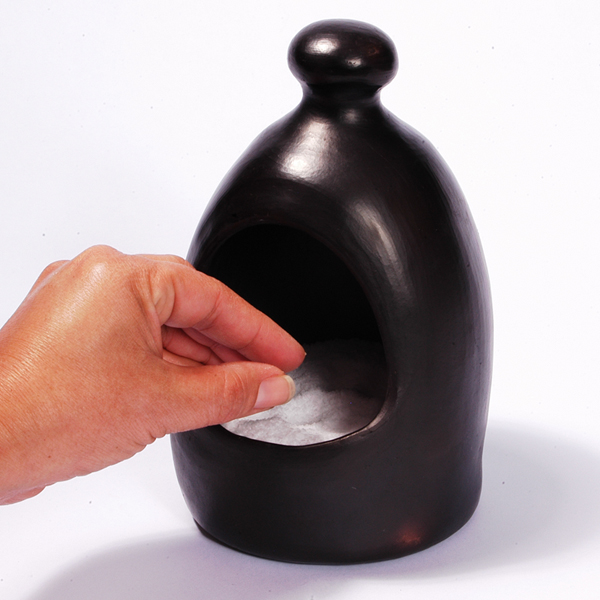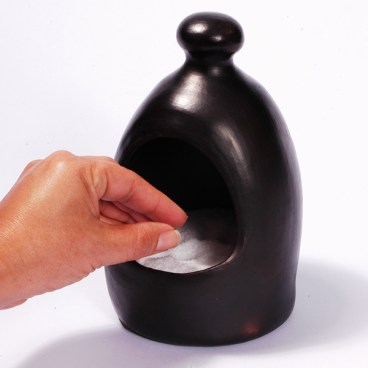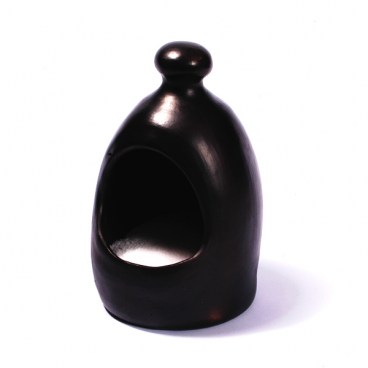Black Clay, La Chamba Salt Pig
About the piece
Care and Use
Curing
How they are Made
There is no better way to accompany your beautiful Black Clay Pots than with this Kcool exclusively designed Black Clay La Chamba Salt Pig. If you’ve never used one, once you do, you will never be able to live without one. The salt stays fresh and convenient for when you need a pinch, grabbing exactly the amount you need.
| Item Number: | COL-7033-07 |
| Dimensions (inches): | |
| Length: | 4.3 |
| Width: | 4.3 |
| Height: | 7.0 |
| How we measure |  |
About Black Clay, La Chamba, Cookware
Black Clay, La Chamba Cookware, is well-known and used throughout Colombia in restaurants and homes for preparing and serving traditional dishes such as Ajiaco. Its origins can be traced back at least 700 years to vases and pitchers found in pre-Columbian archaeological sites. It is still made in the traditional manner, by families in a small village on the banks of the Magdalena River in Central Colombia. The pieces heat very evenly and retain heat for a long period and can be used in the oven, the microwave or on a gas or electric stovetop. They can go directly to the table for a sophisticated presentation.
Because the pieces are unglazed, they are completely natural and safe and contain no toxins or lead. The porous nature of the unglazed clay allows the slow evaporation of steam resulting in using less liquids and fats while cooking which that produces food that is healthier and tastier!
Black Clay Cookware is not only beautiful, but it is also quite sturdy and will last many years with proper use and care. Serving pieces like these can even be used to cook in for such applications as heating a dish, or serving au gratin dishes. They can be used in the oven, the microwave or a stovetop, and can go directly to the table for a sophisticated presentation. The pieces can be used directly on a gas or electric range, however, it is recommended to use a heat diffuser to prevent discoloration from the heat (sold separately).
The pieces must not be submitted to drastic changes in temperature. The pieces should be allowed to adjust slowly to heat, letting them slowly heat up until they are hot, either on the stove or in the oven. Likewise, you should also allow the pieces to adjust to room temperature before washing or storing them, and never sit a hot pot on a cold surface such as granite or tile.
The pieces retain heat for a long period of time, so be careful in handling a hot plate or other item. The video to the right shows a pot which has been brought to the table, yet keeps bubbling for quite some time without any heat source.
For cleaning, avoid using the dishwasher, hand washing is recommended. After each use, fill with warm, soapy water, allowing to soak briefly if heavily soiled, then scrubbing lightly with a sponge or soft cloth.
Do not use metal or abrasive pads as they may scratch the surface and avoid strongly scented soaps which can flavor the clay. Use wooden utensils with the pieces as metal utensils can scratch and damage the inside.
Appearance
As with most handmade products by artisans around the world, the pieces may have slight imperfections in the form or finish of the materials. Sometimes sizes of same model pieces may also vary slightly, however, these imperfection do not compromise the aesthetics or functionality of the pieces and are considered normal and to be expected. Likewise, although lids are made individually to match each pot, they do not always fit perfectly as the two parts may shrink differently during the firing process.
If subjected to direct heat, you may observe that your pieces may change in color on the bottom where there is direct contact with heat. Although this is normal and does not affect the pieces in any way. it is better to avoid direct heat to prevent the discoloration on serving pieces.
Normally before a La Chamba Piece is used for cooking the first time; it should be “cured” to seal the pores. The sealing process really only needs to be done on cooking pots and not on plates, bowls, and other serveware, but for your information, below is the process used to cure a La Chamba piece.
Every culture has different methods of sealing and curing their clay cookware. The video to the right shows the most traditional method used in Colombia which is to warm the clay piece slightly, then thoroughly rub the inside with a ripe plantain (a regular banana will do), leaving a thick coating on the clay. After drying for a bit, the piece can then be lightly washed to remove the residue.
The sealing can also be done with almost any oil, or even as easily as filling the piece with a mixture of milk and water and boiling it for a few minutes. During the boiling, some seepage may occur which is quite normal, however, the boiling action will eventually seal the pores.
You can also cure the piece by sautéing some onions or garlic in the oil of your choice, making sure to wipe the oil up the sides of the piece with a paper towel using tongs.
In a small village on the banks of the Magdalena River in central Colombia, live entire families of talented artisans that make Black Clay, La Chamba Pottery. Like their ancestors have done for 700 years. The process of making Black Clay, La Chamba Pottery has remained virtually unchanged since before the Spanish conquest. Still today, there are no mechanical wheels and each piece is made entirely by hand. It is a laborious process of molding, polishing, and firing.
The entire community is dedicated to the production of these ceramics and it is how the community sustains itself. Rather than one artisan completing an entire piece, families or individuals specialize in certain steps of the process, which make the creation of each piece an entire community affair. After each step is completed, the pieces are then transported by burros, motor bikes or even on top of their heads to other families or individuals who complete other steps and so on until the pieces are completely done and packaged.
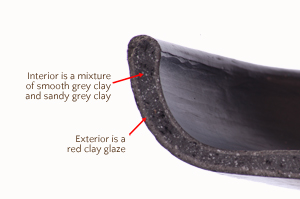 Three different types of clays from local mines are used in the making of these ceramics. They are dissolved in water and strained to remove little stones and other impurities. The interior of the ceramics are made with a mixture of a smooth, grey clay that gives the piece its strength and body, and a sandy grey clay that makes it easier to mold. The exterior is then “glazed” with a watery red clay which gives the piece a smooth surface, and allows for the polishing.
Three different types of clays from local mines are used in the making of these ceramics. They are dissolved in water and strained to remove little stones and other impurities. The interior of the ceramics are made with a mixture of a smooth, grey clay that gives the piece its strength and body, and a sandy grey clay that makes it easier to mold. The exterior is then “glazed” with a watery red clay which gives the piece a smooth surface, and allows for the polishing.
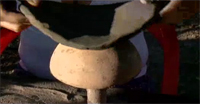 The process begins by flattening a ball of clay and forming it around a mold specifically made for each model. This “shell” is then smoothed and trimmed using tools fashioned from bamboo and plastic pieces.
The process begins by flattening a ball of clay and forming it around a mold specifically made for each model. This “shell” is then smoothed and trimmed using tools fashioned from bamboo and plastic pieces. 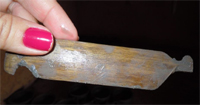 The pieces are then left to air dry, receiving a light polishing during the drying to make sure they have a smooth surface and free of sand. The pieces are then transported to other artisans that specialize in adding rims and/or handles. The handing off progression continues with other artisans which specialize in the production of the lids, which are custom
The pieces are then left to air dry, receiving a light polishing during the drying to make sure they have a smooth surface and free of sand. The pieces are then transported to other artisans that specialize in adding rims and/or handles. The handing off progression continues with other artisans which specialize in the production of the lids, which are custom 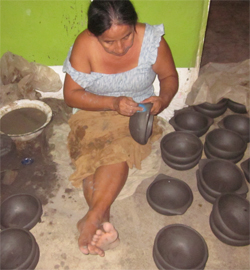 made for each piece. Even the knobs on the lids are made by artisans who specialize in only adding knobs to lids.
made for each piece. Even the knobs on the lids are made by artisans who specialize in only adding knobs to lids.
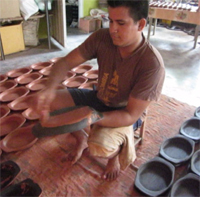 After each step the pieces are laid out to dry in the scorching La Chamba sun. Sometimes the process is delayed due to rains which prevent the drying of the pieces. When it begins to rain, the entire community is mobilized to quickly cover drying pieces that were outside in various production stages. The pieces are then lightly polished with a soft sponge to ensure a smooth exterior, and they are then taken to artisans that glaze each piece with the watery red clay. The glaze is not let to dry completely to allow for the next step of polishing, which is probably the most laborious part of the process, the polishing.
After each step the pieces are laid out to dry in the scorching La Chamba sun. Sometimes the process is delayed due to rains which prevent the drying of the pieces. When it begins to rain, the entire community is mobilized to quickly cover drying pieces that were outside in various production stages. The pieces are then lightly polished with a soft sponge to ensure a smooth exterior, and they are then taken to artisans that glaze each piece with the watery red clay. The glaze is not let to dry completely to allow for the next step of polishing, which is probably the most laborious part of the process, the polishing.
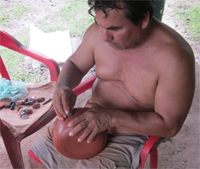 The hand polish, a process known as burnishing, is done by rubbing the entire piece with semiprecious stones until it has a uniform brightness on the surface. Depending on the size of a piece, the polishing can take up to half an hour to an hour. Originally, this polishing was done with smooth river rocks
The hand polish, a process known as burnishing, is done by rubbing the entire piece with semiprecious stones until it has a uniform brightness on the surface. Depending on the size of a piece, the polishing can take up to half an hour to an hour. Originally, this polishing was done with smooth river rocks 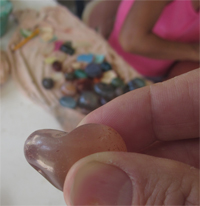 from the bottom of the Magdalena River, but is now done with agate stones brought from Brazil which are stronger. With use, the stones grind down even creating grooves from corners and edges.
from the bottom of the Magdalena River, but is now done with agate stones brought from Brazil which are stronger. With use, the stones grind down even creating grooves from corners and edges.
After the pieces are polished and fully dry, they are taken to be fired in conically shaped, wood burning ovens, although some artisans now use custom made gas kilns which make the process somewhat easier and faster.
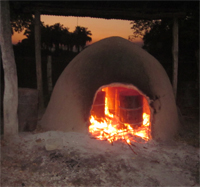 To start the firing process, the pieces are placed inside metal drums, with smaller objects first going inside larger earthenware pieces. These metal drums are then placed in wood burning ovens, usually late in the day so as to minimize the heat to the workers. The firing process takes approximately three hours, with the furnace reaching approximately 750°C. This high heat, together with the glazing and burnishing process, result in utilitarian pieces strong enough to withstand rough treatments and make them ovenproof.
To start the firing process, the pieces are placed inside metal drums, with smaller objects first going inside larger earthenware pieces. These metal drums are then placed in wood burning ovens, usually late in the day so as to minimize the heat to the workers. The firing process takes approximately three hours, with the furnace reaching approximately 750°C. This high heat, together with the glazing and burnishing process, result in utilitarian pieces strong enough to withstand rough treatments and make them ovenproof.
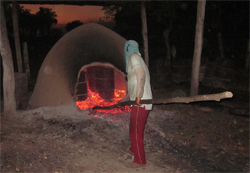 After the firing comes probably the most interesting part of the entire process and is what gives the pieces their unique black color. The metal drums are pulled out of the ovens with the help of long sticks.
After the firing comes probably the most interesting part of the entire process and is what gives the pieces their unique black color. The metal drums are pulled out of the ovens with the help of long sticks.
Processed vegetable materials in the form of saw dust, rice husks, or other materials are then added to the metal drums with the white hot clay pieces still inside. The materials immediately catch fire and begin to smoke. 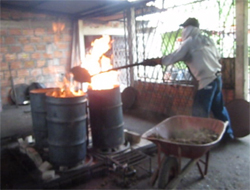 The drums are then covered to extinguish the flames but keep the material smoking vigorously for quite some time. The smoke penetrates the pieces giving each piece the black color that so characterizes products from La Chamba.
The drums are then covered to extinguish the flames but keep the material smoking vigorously for quite some time. The smoke penetrates the pieces giving each piece the black color that so characterizes products from La Chamba.
The entire village and artisans are extremely proud of their products, as we are bringing them to you. 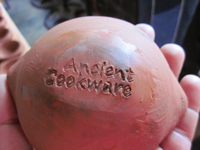
Related Products
Reviews
As with all La Chamba products, it will be a beautiful, one-of-a-kind accessory on your cooktop or stove. This salt pig has good capacity & the opening is big enough for larger hands. This unit was a replacement for a nice Emile Henry that I needed a small spoon to get anything out of. Unit stands just over 7" tall & the base diameter is slightly over 5".EGL
Beautiful and authentic appearing natural clay salt pig. It is just what I wanted.
Gene Jensen
Very good quality, beautiful craftsmanship, and lots of room for lots of salt! :)jadeets




